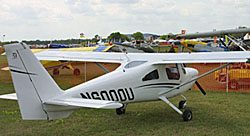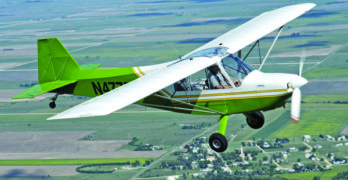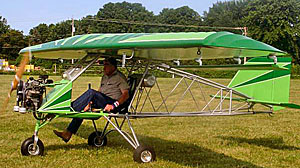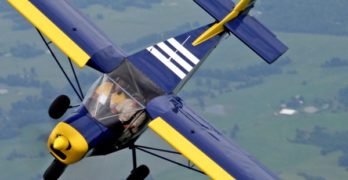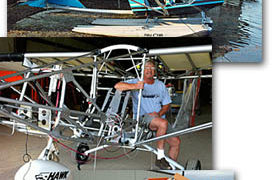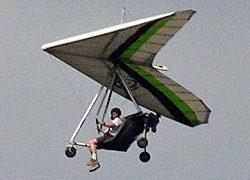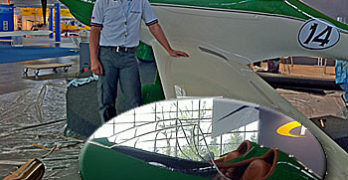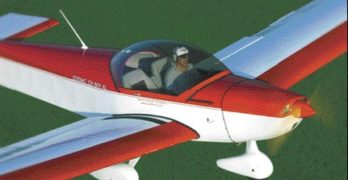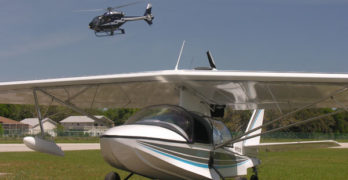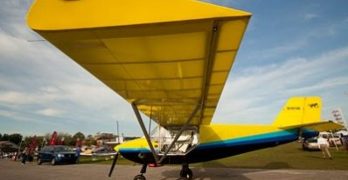Whew! It’s over. Man, Sun ‘n Fun can be the busiest six days of one’s life… well, at least until the next one. In this survey article, I want to skim the very top of what I found interesting at the recently concluded show. Each highlight will get fuller coverage. Before starting, though, I owe a couple shout-outs. *** A huge, enormous thanks to Jim Lawrence who kept you up on a daily basis. Accomplishing that means long days shooting photos, interviewing personalities, and working into the night in a motel room with a crappy Internet connection. It may look easy and fun but only half that assessment is true (hint: it ain’t easy). *** Secondly, another thanks-a-million to UltralightNews, my video collaborator. I have the easy job; they will put in an enormous number of hours to edit and finish more than two dozen new videos that I’ll post here as each is done.
Search Results for : Four stroke and ultralight
Not finding exactly what you expected? Try our advanced search option.
Select a manufacturer to go straight to all our content about that manufacturer.
Select an aircraft model to go straight to all our content about that model.
Rans S-7 Courier LS
Available Fully Assembled or as a Kit
Unlike the flock of internationally
designed Special Light-Sport Aircraft,
RANS is a familiar name to Americans.
Even closer to home, ultralight enthusiasts know
the brand very well; ultralight aviation is the
arena that gave designer Randy Schlitter his
start. I first recall seeing the brand at Sun ‘n
Fun around 1984. And each year subsequently, it
seemed, Randy showed up with something new.
Not long into this profusion of new designs came
the S-7.
“The design of the S-7 originated out of the
need to train [single-place] Coyote I pilots,”
Randy explains, “so the cockpit was set up the
same with throttle on the left, and stick in the
middle.” Randy adds that he named the Courier
in honor of one of his favorite planes, the STOLperforming
Helio Courier.
The S-7 Courier was the first 2-seater produced
by RANS, dating to 1985 when the first prototype
flew, succeeding the S-4/5 single-seater that
kick-started the aviation business of the nowwell-
known airplane manufacturer.
Not Your Average Backyard Flyer
One of my joys at AirVenture 2011 was visiting a seemingly revitalized Ultralight Area. Though a shadow of its former self in the 1980 heydays, new life seemed to be springing up, whether through electric powered aircraft or affordable Part 103 fixed wing designs.
Proving the naysayers wrong (again!) were at least two intriguing Part 103 airplanes you can buy and fly today for less than $20,000. That’s well the under the average price of a new automobile for a ready-to-fly aircraft with desirable features, not a stripped-down machine that no one really wants. I wrote about Terry Raber’s lovely little Aerolite 103. A day after looking over his work, UltralightNews and I shot a video review of the Valley Engineering Backyard Flyer. Once again, I had my eyes opened.
If you’ve ever visited AirVenture’s Ultralight Area, odds are you saw a pilot known as the “Flying Farmer” doing circuits of the Ultralight Area pattern.
Zenith’s CH 701 Kit is Sport Pilot-Ready
Every Light Sport & Ultralight Flying magazine reader has probably heard of off-road vehicles. How about an “off-airport” flying machine? You may not have used the term but you probably know one of the candidates: Zenith Aircraft’s highly functional CH 701.
No one calls the CH 701 the most handsome aircraft in the fleet. That title may be better reserved for sleek carbon fiber jobs. But as a practical aircraft appealing to ultralight enthusiasts, the Chris Heintz design with a 20-year history is head of its class. While the design has not changed much in those two decades, the kit has changed quite a bit to make the builder’s effort easier.
The designs of engineer Chris Heintz have been around a long time, beginning with his early Zipper ultralight-like aircraft. A prolific and versatile creator, his aircraft models have put nearly 3,000 builders in the air. The low-wing CH 601 series is the most popular at better than 60% of all Zenith models followed by more than 700 CH 701’s now flying around the world.
The Range of LSA is Wide as the USA
Plenty of folks think LSA are mainly carbon fiber speedsters with autopilots and huge computer screen instrumentation. No doubt, we have some beauties that are equipped like luxury sport planes. If you’ve got the budget, the Light-Sport industry has the aircraft. Yet not everyone can afford those birds and not everyone wants one. *** FAA pretty much eliminated ultralights when they came out with the SP/LSA rule… well, except for genuine ultralights of the single place variety. The latter still exist, and yes, you can still buy a ready-to-fly ultralight “vehicle” for which you need no N-number, no medical, and no pilot license. Those 254-pound (max empty weight) aircraft prove America remains the land of the free and I, for one, love to fly them. *** On our way north for AirVenture my wife, Randee, and I made a series of stops. In Alabama — just a mile apart — we hit two fixed wing producers of “ultralights” that qualify as official SLSA.
Which Kind of Pilot Are You?
I’ve observed aviation for more years than I’m comfortable admitting. As an aviation journalist I’ve often had a front row seat. I’ve talked to a ton of pilots (one of the great joys of my life is to have met so many fine folks). Over those years, I’ve distilled the kind of pilots we are to one or the other. Yes, just that simple: this kind or that. *** I believe you either fly to “Get Up,” or “Go Long.” Go Long flyers include all those who want to go some distance in their flying machine. Flying your own plane is a great way to travel. Speed is a big part of why flying is useful but that quality is merely one aspect of the enjoyment. *** Me? Sure, I like to Go Long. I’ve logged hundreds of hours of cross country flying, to all corners of America and some out of the USA.
Aero 2011 Pre-Show Attention Getters
The major European Airshow, Aero, opened this morning with the usual unveiling of new designs but one aircraft appeared to be the center of attention. Peter Funk had an idea five years back but shelved it for other projects. Now the time is right for his distinctly retro treatment of one of Light-Sport aviation’s sharpest designs, the Fk14 Polaris (Alert readers will identify Polaris as the Cirrus SRS, that GA company’s onetime entry in the LSA sweepstakes.) *** Even experts accustomed to following the latest in new or updated designs were caught off guard by the unorthodox entry (photo). With dual windscreens and race car bodywork, the open cockpit creation charmed many who gained early access to the great exhibit halls of Aero… 11 of them, each the size of a gymnasium. While exhibitors were assembling their displays Fk Lightplanes’ staff grabbed lots of attention with their Fk14 Lemans. *** Constrained by their ongoing contract with Cirrus until the end of the year, Fk Lightplanes sought permission before revealing Lemans and sales will not happen in 2011.
Budget Builds (Low Cost Homebuilts)
Yes! You can build and fly a “real” airplane for the cost of a new SUV.
Contrary to popular opinion,
airplanes don’t have to be outrageously
expensive-at least not
all of them. The Sport Pilot/Light-Sport
Aircraft initiative is one program that
promises to lower the cost of ready-to-fly
aircraft. But many of these Special LSAs
and Experimental LSAs will be priced
well more than $40,000 and can run
upwards of $85,000.
One way to get airborne for less
than $40K is to choose an ultralight,
powered parachute or weight-shift
trike. But if you want something more
conventional, more comfortable or
larger, you’re likely to find what you
want in the world of kit aircraft. After
all these years, building an Experimental/
Amateur-Built airplane still qualifies
as one of the least expensive ways
to get a get a great airplane into the air
on a reasonable budget.
Our $40K benchmark is designed
to narrow the field for builders on a
budget-and that benchmark means
a completed, ready-for-flight airplane.
SeaRey… American-Made Amphibian
SeaRey Sets a New Standard for Floatplanes
Many pilots who have flown in water-borne aircraft believe this is the
finest and most enjoyable flying one can do.
If that statement holds water (is true), then the beautiful SeaRey amphibian
from Florida-based Progressive Aerodyne should be one of the most desirable
aircraft you can buy.
Pilots have spoken with their money. Since it arrived on the market in 1992,
the SeaRey has sold in increasing numbers each year.
Three years of Progressive Aerodyne history hardly tells the story behind
the SeaRey. A father and son ownership team, Wayne and Kerry Richter have
long experience in this business producing many hundreds of amphibious
ultralights.
The Richters were principals in a company called Advanced Aviation best
known for its amphib sea plane called the Buccaneer. After another designer
made the first single place Buccaneer, Kerry Richter made his name with a
two place model.
Sun ‘n Fun Day 2: Toto, Are We…?
…back in Kansas? Little Totomeister, I gotta say, the winds blew so strong today I saw a full chicken caesar salad in its covered plastic container sail horizontally by my head like a UFO on a mission. *** I even had to postpone a photo shoot until tomorrow at dawn. Oh joy. *** No complaints though. It was a gorgeous day which started out with a very enjoyable hour-long demo flight in the Rans S-6ELS, a lovely airplane I’ve touted lately for its low price – $63,000. *** My demo pilot, Mark Pringle (“Just like the potato chips,” he said) took me up for some turns, dutch rolls, stalls, and a couple landings in a mildly bumpy airmass, at least for 8:30 this morning. *** First impressions (look for my flight report in an issue soon) — throttle in, rolling down the runway, one-thousand-one, one-thousand-two…hey, we’re airborne already? That lightweight flivver fairly hopped into the air.
- « Previous Page
- 1
- …
- 7
- 8
- 9
- 10
- 11
- …
- 17
- Next Page »


